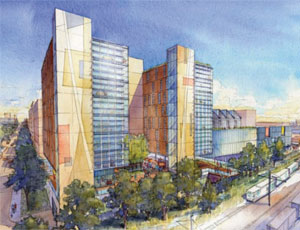The Denver Housing Authority is getting the most out of its grant writing in winning five ARRA funding opportunities.

In a remarkable accomplishment, the Denver Housing Authority recently won five of five competitive grants for American Recovery & Reinvestment Act stimulus funds totaling $27 million for public housing capital improvements. The funds include renovations and new construction.
Of the $4 billion in ARRA stimulus money distributed by the U.S. Dept of Housing and Urban Development earlier this year, $3 billion was assigned to public housing nationwide based on the number of housing units held by the respective agencies. Denver, with a total of 3,800 units, received roughly $7.8 million.
The remaining $1 billion was allocated on a competitive basis. “Agencies such as ours, able to leverage other resources and having high-quality projects ready to roll that met sustainability and affordable-housing requirements, were well positioned for the competitive round,” says Ismael Guerrero, executive director of the DHA.
Winners of the grants were notified in September. “We were strategic with our initial award of $7.8 million,” Guerrero says. “No funds were committed until we could be certain about the results of the competitive round. Given the concerted effortby our in-house team, the result, quadrupling our budget to $35 million, was especially gratifying.”
DHA is currently moving ahead to allocate the funds and launch projects within the requisite 12-month period that began Sept. 30. “We want to allocate all the ARRA funds this fall, so we can go out to bid in first-quarter 2010,” Guerrero says.
Statewide, Colorado received more than $180 million in ARRA funding, nearly $137 million in the latest round and $53 million last spring that went toward neighborhood stabilization programs. Decisions regarding distribution of much of the $137 million are still pending.
“Sustainable, affordable, energy-efficient, TOD (transit-oriented development) was a key element of the high-profile visit to Denver by HUD secretary Shaun Donovan on Sept. 18,” says Debra Griswold, HUD deputy secretary in Denver. Griswold says the visit, which included Transportation Secretary Ray Lahood and EPA Administrator Lisa Jackson, was intended to call attention to the Obama administration’s new urban policy agenda.
“By establishing a mechanism to quickly resolve challenges that might arise, federal agencies intend to make it easier for states and municipalities to utilize our programs,” Griswold says.
| DHA ARRA Stimulus-Funded Projects | |
|
Park Avenue Redevelopment Park Avenue Redevelopment South Lincoln Tower |
Mulroy Apartments and Opportunity Center Westwood Homes Transformation Columbine Homes |
TOD at South Lincoln Park
The upcoming South Lincoln Park development, which received $10 million in ARRA funding, is a good example.
Located near the 10th and Osage light-rail station, phase one of the TOD project’s master plan, completed prior to ARRA, called for 100 residences, but it lacked the funding to start construction. “Once the stimulus money became available, we kicked off phase one,” Guerrero says. “We are currently seeking an architect and assembling a design-build team.”
Construction of the high-rise residence for seniors at mixed-income levels is scheduled to start in late summer.
“Improvements to existing public housing planned for the next two to four years can now begin to move forward,” Guerrero says. “Also, for the first time in nearly 20 years, we are able to build new, affordable homes for families that need subsidized housing.
“Most of these projects are in planning and procurement. RFPs will be going out over the next few weeks.”
Meanwhile, DHA has begun purchasing supplies such as water heaters for Columbine Homes and planning renovations at Westwood Homes (see related sidebar), where the agency has already completed a new community center, installed utility lines and retained architect Parikh Stevens to design new interiors.
ARRA stimulus money has provided DHA the opportunity to finish the rental portion of its ambitious 873-unit Park Avenue Redevelopment, recently renamed Benedict Park Place. Construction began in 2004 and is set to finish in May 2011. Unfortunately, start-up of the 283-unit ownership segment, Blocks 1A, 3A, 4A and 5A, remains stalled by the downturn.
Rental Blocks 2 (rehab of Thomas Bean Towers, 189 units), 1B (124 units) and 3B (91 units) have been completed, while 4B (90 units) is due to finish in December. 5B started construction in November. Originally designed for 70 units, 5B, the final rental phase, has been expanded to 90 units.
“Long-term, we have no concerns about the ownership segment because it remains an extremely desirable TOD location adjacent to light rail and within walking distance of downtown, but our private development partners need for the recovery to kick in before they can break ground, ” Guerrero says.
Plans call for 25% of the ownership units to be affordably priced.
“Denver is being showcased as a national model for transforming neighborhoods by making them greener, more affordable, safer places to raise families.” Griswold says. “Colorado has led the push for renewable, alternative energy and smart, sustainable development. That’s why it was selected as a prime location to promote the Obama agenda.”


Post a comment to this article
Report Abusive Comment